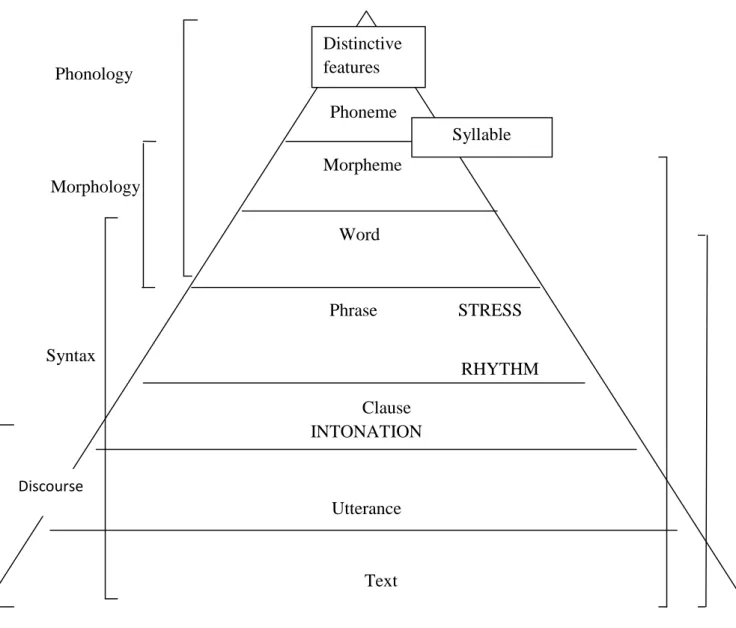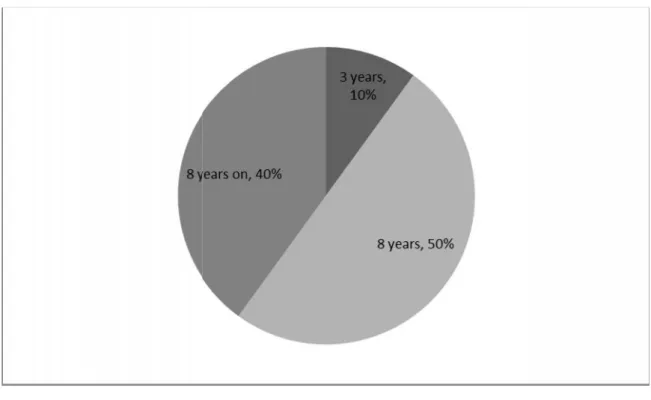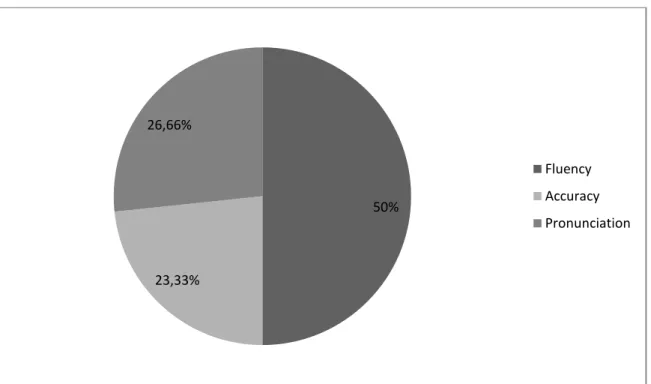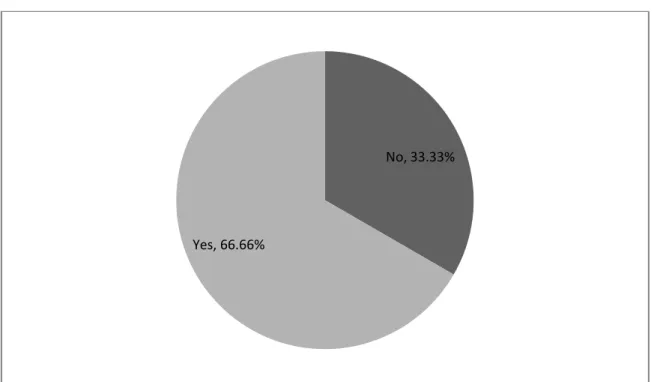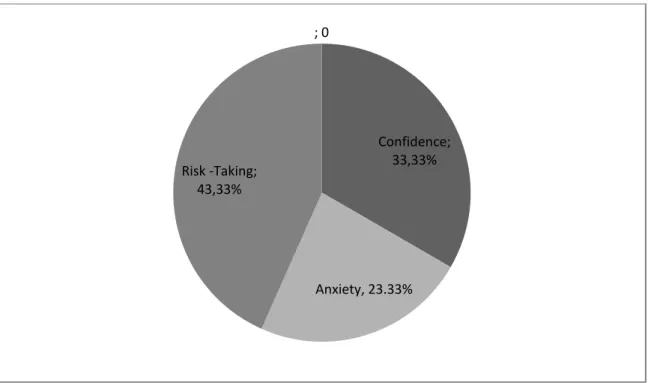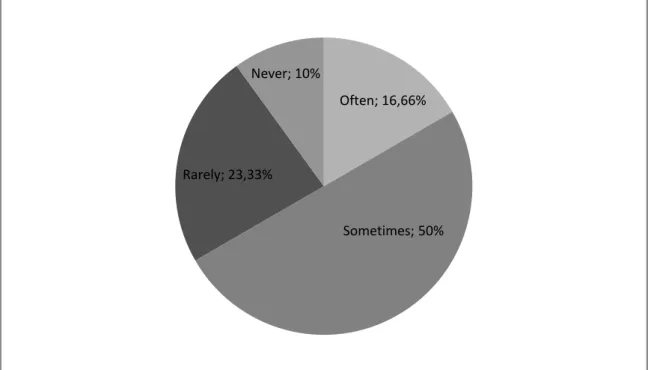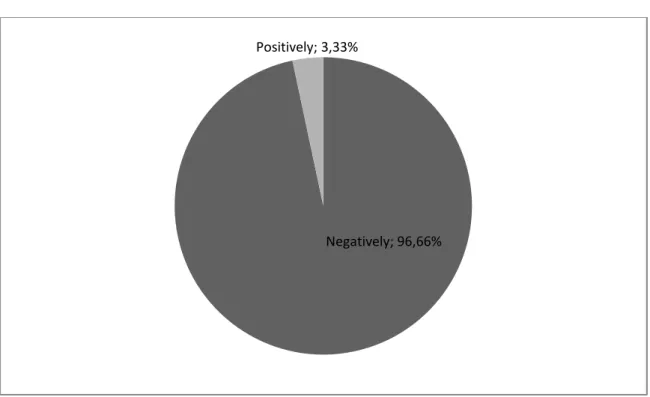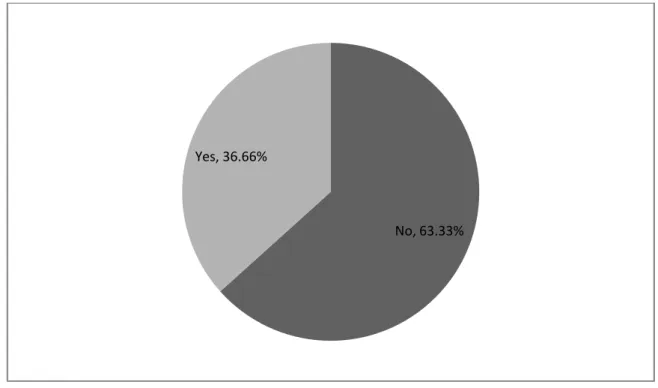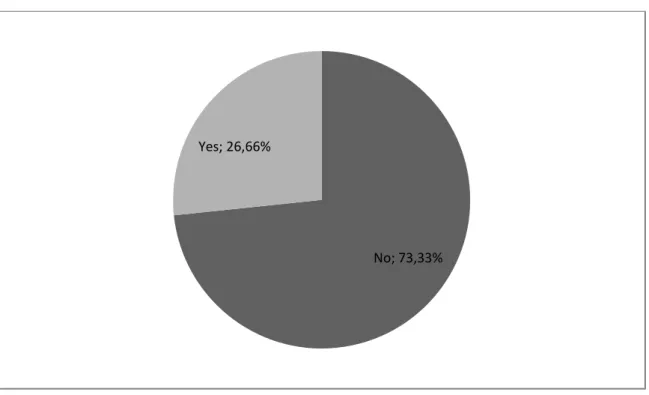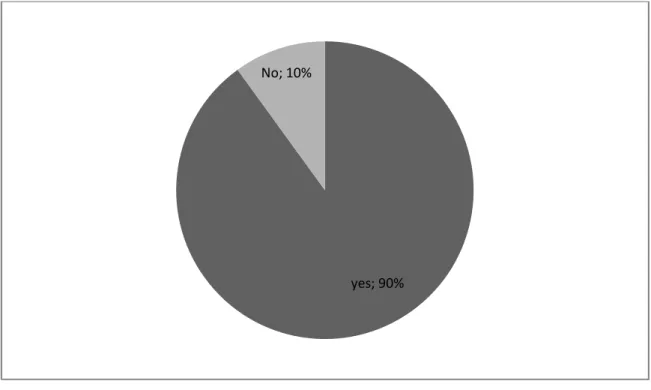People’s Democratic Republic of Algeria
Ministry of Higher Education and Scientific Research
University Mentouri Bros. Constantine
Faculty of Letters and Languages
Department of Letters and the English Language
Thesis submitted to the department of Letters and English Language in candidacy for the degree of Doctorat LMD in Language Science and English Language Teaching
By Miss: Naouel BOUCHAREB Supervsised by: Pr. Hacéne SAADI
Board of Examiners
Chairman: Prof. Riad BELOUAHEM University Mentouri Bro. Constantine 1 Supervisor: Prof. Hacène SAADI University Mentouri Bro. Constantine 1 Member: Prof. Nacif LAABED University Mentouri Bro. Constantine 1 Member: Prof. Abdelhak NEMOUCHI University Alarbi Ben Mhidi Oum El Bouaghi Member: Prof. Hacéne HAMADA University Mehri Constantine
Member: Dr. Charif BENBOULAID University Benboulaid Batna.
2017- 2018
The Effects of Risk- taking and Anxiety on the Foreign
Language Oral Fluency
Case Study: Second Year Students at the Department of
English, University Mentouri Bro. Constantine
N°ordre:24/D3C/2019 N°serie:04/Ang/2019
Dedications
I dedicate this thesis to my beloved family, especially my parents who have been a great source of motivation and inspiration.
To the memory of the one I am proud to bear his name, my father Ammar whose words of encouragement and push for tenacity still ring in my ears. I know, without a doubt,
that the reason why I am here is because he prepared the way for this dream to come true. And to Samia Zatout the one who breastfed me with tenderness and love, my success is the secret behind her prayers for me. This is for you, Mom, thanks for always being there for me,
may you forgive me for refusing to do home chores to finish my thesis. I love you Mom, I love you Dad.
To my sisters who were always praying for me to finish this work, to Ilhem, Wafa, Ahlem and my little sister Celine. The older we grow, the closest we become. Thank you for smiling along with me and for making me smile, too. I could never forget the days I was upset
and your proposal to go out for a walk provides me with strength, refreshment, and work more, for everything I love you. You have a special space in my heart.
To my brothers Mouhamed, Khalid, and Sief El Islam who are always lightening my way with their security. I am wishing you all, also, to reach your dreams.
To all the members of my family, a warm thank you for your patience and comprehension, for the moments I could not share.
Acknowledgments
Praise is to Allah my Lord, who has bestowed upon me in completing this thesis. Peace and blessing upon our great teacher and messenger prophet Muhammad SAW, (May Allah bless and grant him, his families, his companion, and his followers).
I am deeply thankful to my supervisor Prof. Saadi Hacéne the one who always keeps on encouraging us with his affective psychological ways, and for his efforts and generosity in dividing our time for what to do, from waking up in the morning to sleeping at night to finish our work, and most importantly for his provision with all the necessary references for our theses. Thank you Professor to teach me how to light the candle, not how to curse darkness.
I am also grateful to all those who have been my teachers along my University years, particularly: Prof. Abderahim for her time, efforts and care, Prof. Nemouchi for his support and enthusiasm, I cannot describe how much I am indebted to Prof. Belouahem who gave us assistance and facilities, and thanks to the encouragement I received from Prof. Kaouwash, to Prof. Hamada who planted the optimism in our path with his continuous academic guide, also to Prof. Laabed for his valuable enthusiasm and precise information. I gratefully acknowledge our head of the department Mr. Boughanout for his academic assistance.
I would also like to humbly thank my committee members, namely, Prof. Hacéne Hamada, Pr. Abdelhak Nemouchi, Prof. Riad Belouahem, Prof. Nacif Laabed, Dr. Cherif Benboulaid, particularly, for their detailed feedback on all aspects of this thesis and their provision of valuable insights.
My class friends and my new colleagues are mostly thanked.
Without forgetting to approve my students who helped in the practical part of this thesis.
Abstract
Psychologists, educators, and sociologists have long been emphasizing the importance of learners’ emotional side to the academic growth. In that context, the present study aims at focusing on learners’ attention to the significance of what happens inside them, singling out anxiety, and risk-taking as strategies for enhancing their speaking fluency level and exploring possible relationships between the two variables. It is hypothesized that if teachers can encourage students to take risk in speaking and not to be anxious, then their oral fluency level would improve consistently. Thus, the less learners are anxious and the more they are risk-takers, the more they will become fluent in the EFL speaking. The methods used in this research are both quantitative and qualitative ones. Accordingly, three groups (90 students) of English at Constantine University are selected, and after conducting an interview with the researcher, are divided into anxious and non-anxious, this is being the result of their answers to the Foreign Language Classroom Anxiety Scale, and as being risk- takers and non-risk takers after exploring their answers to the risk- taking questionnaire. Learners̕ obtained marks from the scales are correlated with their marks of a story narration task, and their exam measuring oral fluency by calculating the coefficient of correlation. Besides, a questionnaire is delivered to Algerian teachers of Oral Expression of English at University of Constantine, Department of English. The inquiry highlights that there is a positive relation between learners’ risk- taking and their oral fluency level, but a high negative relation between anxiety and their speaking fluency. Analysis and interpretation of data suggest some implications for language pedagogy, for EFL teachers to pay moreattention to theirlearners’ affective side, and for students to raise their awareness to be risk- takers and to become less anxious to speak English fluently.
List of Abbreviations
ALM: The Audio-Lingual Method.
CAF: Complexity, accuracy, and fluency.
CLT: Communicative Language Teaching.
D.M: The Direct Method.
E.F.L: English as a Foreign Language.
E.L.T: English Language Teaching.
ESL: English as a Second Language.
F.L: Foreign Language.
FLCAS: Foreign Language Classroom Anxiety Scale.
GTM: The Grammar Translation Method.
IDs: Individual Differences.
L: Learner.
LMD: License, Master, Doctorate.
L2: Second Language.
MLR: Mean length of Run.
N: Negatively Worded Item.
P: Positively Worded Item.
Q: Question.
(r): Correlation Coefficient.
SLA: Second Language Acquisition.
Ss: Students.
T: Teacher.
T.E.F.L: Teaching English as a Foreign Language.
USA: United States of America.
X: Students Answers in the Questionnaires.
Y: Students Marks in the Tests.
%: Percentage.
List of Tables
Table 1: Teachers’ Academic Degree……….………..84
Table 2: Years’ of Experience in Teaching English as a Foreign Language ……….…..86
Table 3: Years’ Number of Teaching the Oral Expression Module………….…………..…..87
Table 4: Teachers’ Evaluation of Learners’ Level……….….…..88
Table 5: Teachers’ Views about Students’ Participation in Oral Expression………...…90
Table 6: Teachers’ Criteria for Assessing Speaking……….………...……….91
Table 7: Teachers’ Remarks about some Shortness in Students’ Talk………...……….…….93 Table 8: Teachers’ Mentions of Learners’ most Occurring Problems once Learners̕ Talk..…94 Table 9: Teachers’ Considerations Concerning Learners’ Non- fluent Speech………...…96
Table 10: Teachers’ Habits to Raise Students’ Consciousness to Notice the Gap between What to Say and How to Say It……….………...……….……98
Table 11: Teachers’ Advice to Learners about the Importance of Fluency…………..………99
Table 12: Teachers’ Opinions about What characterize Fluent Learners from Non Fluent Learners in Terms of Personal Characteristics……..………..100
Table 13: Teachers’ Views about Learners Who Suffer Disfluencies…...……..………...…102 Table 14: Teachers’ Views about Their Efforts for Students to Be Fluent…...…...……...…103 Table 15: Mention those Efforts If Any………...………...………105 Table 16: Teachers’ Advice to Learners Concerning Learners’ Fluency Indices…...…..…..106
Table 18: Teachers’ Views about the Contributing Element That May Help Learners’ Enhance their Fluency………...………..…………109
Table 19: Teachers’ Views about the Necessity of Being Fluent for Learners Who Talk...110 Table 20: Teachers’ Views about Learners Concerning the Necessity of Having a Fluent Tongue If Having Good Pronunciation………...………….………..….112
Table 21: Teachers’ Opinions about the Role of Taking risks as an Important Individual Difference for Learners’ Success………113
Table 22: Teachers’ Opinions about the Role of Risk -taking Behaviors in Facilitating Speaking Acquisition……….……….……115
Table 23: Teachers’ Views about Learners Who Participate If More Risk- takers than Others………...………...116
Table 24: Teachers’ Views about Pushing Learners to Talk...………..…….118
Table 25: Teachers’ Opinions about the Dynamic Correlation between Learners Level of Fluency and Being Risk- takers in Speaking…………..………..…..…119
Table 26: Teachers’ Opinions about Learners Who Dare Participating in Oral Sessions If More Fluent than Passive Ones………..………….120
Table 27: Teachers’ Views about Learners Who Participate Lot………...………....122
Table 28: Teachers’ Views about Ignoring Learners Chances in Speaking for a Period If will Affect Their Fluency…………...………...……….…123
Table 29: Teachers’ Views about the Final Result of Learners Who Participate since the Beginning of the Year……….125
Table 30: Learners’ Age………...………..136
Table 31: Learners’ Gender………...……….137
Table 32: English Language as a First Choice for Learners……….…………..……139
Table 33: Learners̕ Reasons for Choosing English Language………...…....140
Table 34: Number of Years of Studying English……...……..………...…………141
Table 35: Students’ Consideration about Their Level in Speaking………..…..143
Table 36: The Students Most Preferable Module………...………....144
Table 37: Learners’ Opinions about Speaking a Language As an Important Component in the Process of Learning it……….…………146
Table 38: Learners’ Opinions about Feeling Stressed in Oral Modules in Comparison to Other Modules………..…… 147
Table 39: Students’ Reasons for Communication………...………149
Table 40: Learners’ Views about the Existing of Emotions Inside Them that Push Them to Talk Fluently…………...……...………..…...…………150
Table 41: Learners’ Views about whether Anxiety Can Determine How Fluent They Are...151
Table 42: Learners’ Views about Having Sufficient Time and Opportunities to Talk in the Classroom Sessions……….…153
Table 43: Students’ Reasons for Participation………...…...………...155
Table 44: Students’ Views about Mistakes Made During Speaking………...156
Table 45: Learners’ Views about Comfort to Communicate As a Reason to Be Fluent…....158
Table 46: Learners’ Feeling about Teachers’ Criticism………...………...…159
Table 47: Students’ Opinions about Avoiding Being Called by the Teacher if they Feel They Are Not Fluent enough to Talk..………...………...…….. 160
Table 48: Learners’ Views about Fluency As Problematic When They Feel Nervous…..…162
Table 49: Students’ Hesitation Once Talking to Their Teacher……...………..………163
Table 50: Learners’ Production of Stops in Their Speech When They Fear Talking to Their Classmates………...………165
Table 51: Learners’ Attitudes toward Anxiety As a Changeable Status and Its Relation to Fluency Development..……….………..166
Table 52: Learners’ Consideration about Their Low Achievement in Oral Fluency As a Result of Not Participating……...………...……….……..……168
Table 53: Learners’ Preferences to Take Risks to Speak in the English Class Even If They Have the Answer………..………..….……….…...170
Table 54: Learners’ Reasons for Being Fluent As Risk- takers………….………...………..171
Table 55: Learners’ Level When They Do Not Speak for Long Time………...……172
Table 56: Learners’ Level of Fluency When They Take Risks...………...……174
Table 57: Learners’ Habits in Speaking………...………...175
Table 58: Learners’ Hesitation When Another One Talks Before Them…………...…....…177
Table 59: Learners’ Refusal of Participation When They Are Not Sure How to Convey the Idea... 178
Table 60: Learners’ Disengagement in Taking Risks if They Repeat the Same Mistake in Fluency Orally..………..…...…..179
Table 61: Learners’ Remarks for the Role of Practicing in the Oral Session...………...…181 Table 62: Learners’ Considerations for the most Serious Problem…………...……….……182
Table 63: Learners’ Consideration for Mistakes Committed in Speaking……...……...……183
Table 64: Students’ Choices for Speaking Fluently……...………..………...185
Table 65: Learners’ Age……...……….……..……...192
Table 66: Learners’ Gender…………...………..……...193
Table 67: English As a First Choice………...…..195
Table 68:Learners̕ Reasons for Choosing English Language………...………….196
Table 69: Number of Years Studying English………....197
Table 70: Who Does Most of the Talk in the Classroom in Oral Expression...198
Table 71: I Never Feel Quite Sure of Myself when I am Speaking in My Oral Foreign Language Class…………...200
Table 72: I Do Not Worry about Making Mistakes in Oral Language Class……….…...….202
Table 73: I Tremble When I Know that I Am Going to Be Called on in Oral Language Class………...….203
Table 74: It Frightens Me When I Do Not Understand What the Teacher is Saying in the Oral Foreign Language ………...205
Table 75: It Would Not Bother Me At All to Take More Oral Foreign Language Classes....206
Table 76: During Oral Language Class, I Find Myself Thinking about Things That Have Nothing to Do with the Course ………...………...208
Table 77: I keep Thinking That the Other Students Are Better at Speaking Languages Than I Am………...………210
Table 79: I Start to Panic When I Have to Speak without Preparation in the Oral Language Class ....………..……….213
Table 80: I Worry about the Consequences of Failing My Oral foreign Language Class...215
Table 81: I Do Not Understand Why some People Get so Upset Over Oral Foreign Language
Classes………...…..216
Table 82: In Oral Language Class, I Can Get so Nervous I Forget Things I Know...218
Table 83: It Embarrasses Me to Volunteer Answers in My Oral Language Class...219
Table 84: I Would Not Be Nervous Speaking the Foreign Language with Native Speakers.221 Table 85: I Get Upset When I Do Not Understand What the Oral Language Class Teacher is Correcting………222
Table 86: Even If I Am Well Prepared for the Oral Language Class, I Feel Anxious about it………...224 Table 87: I Often Feel Like Not Going to My Oral Language Class... 225
Table 88: I Feel Confident When I Speak in Oral Foreign Language Class...227 Table 89: I Am Afraid That My Oral Language Teacher is Ready to Correct Every Mistake I Make………228
Table 90: I Can Feel My Heart Pounding When I Am Going to Be Called on in the Oral Language Class...………230
Table 91: The More I Study for a Language Test, the More Confused I Get...231
Table 93: I Always Feel That the Other Students Speak the Foreign Language Better Than I Do………...……….234
Table 94: I Feel Very Self- anxious about Speaking the Foreign Language in Front of Other Students………...…236
Table 95: Oral Language Class Moves so Quickly I Worry about Getting Left Behind……237
Table 96: I Feel More Tense and Nervous in My Oral Language Class Than in My Other Classes...239
Table 97: I Get Nervous and Confused When I am Speaking in My Language Class…..….240 Table 98: When I Am on My Way to Language Class, I Feel Very Sure and Relaxed...…...242
Table 99: I Get Nervous When I Do Not Understand Every Word the Oral Language Teacher Says………...………..………243
Table 100: I Feel Overwhelmed by the Number of Rules I Have to Learn to Speak a Foreign Language………..………..……..…...245 Table 101: I Am Afraid That the Other Students Will Laugh At Me When I speak the Foreign Language……….246
Table 102: I Would Probably Feel Comfortable Around Native Speakers of the Foreign Language……….248
Table 103: I Get Nervous When the Oral Language Teacher Asks Questions Which I Have Not Prepared in Advance...250 Table 104: Pearson Correlation Coefficient between the Scores Obtained from the Anxiety Classroom Scale and the Story Description Task…………..………...257
Table 106: Oral Expression Level Can Develop through Mistakes I Make………….….….263
Table 107: I Ask Questions Each Time I Do Not Understand Something about the Language……….264
Table 108: Oral Expression Session is a Risky Situation for Me…...………..………..266
Table 109: I Learn by Heart Sentences Before I Participate………..……….267
Table 110: The Remarks Given by My Teacher Always Help Me to Ameliorate My Level.269
Table 111: My Classmates Are a Source of Shyness When I Plan to Talk………270
Table 112: Oral Expression Activities Are Enjoyable………..………..272
Table 113: I Often Compare Myself With Other Classmates in the Oral Expression Level..273
Table 114: I Would Like to Meet Native Speakers to Practise My English With Them…....275
Table 115: Pearson Correlation Coefficient between the Scores Obtained from the Risk-taking Scale and the Exam Task……….………281
List of Figures
Figure 1: Interaction in the Language Curriculum: Awareness, Autonomy, and
Authenticity………...33
Figure 2: Teachers’ Academic Degree……….……….…..……..85
Figure 3: Years’ of Experience in Teaching English as a Foreign Language...86
Figure 4: Years’ Number of Teaching the Oral Expression Module ………...…..87
Figure 5: Teachers’ Evaluation of Learners’ Level ……….89
Figure 6: Teachers’ Views about Students’ Participation in Oral Expression …………...…..90
Figure 7: Teachers’ Criteria for Assessing Speaking ……….……….….92
Figure 8: Teachers’ Remarks about some Shortness in Students’ Talk …….………..…93
Figure 9: Teachers’ Mentions of Learners’ most Occurring Problems once Learners̕ Talk...95
Figure 10: Teachers’ Considerations Concerning Learners’ Non- Fluent Speech ……..…….97
Figure 11: Teachers’ Habits to Raise Students’ Consciousness to Notice the Gap between What to Say and How to Say It ………..……..98
Figure 12: Teachers’ Advice to Learners about the Importance of Fluency………...99
Figure 13: Teachers’ Opinions about What Characterize Fluent Learners from Non Fluent Learners in Terms of Personal Characteristics ………..……….101
Figure 14: Teachers’ Views about Learners Who Suffer Disfluencies ...………...……...….102
Figure 15: Teachers’ Views about Their Efforts for Students to Be Fluent...104
Figure17: Teachers’ Advice to Learners Concerning Learners’ Fluency Indices ….………107
Figure 18: Teachers’ Views about Being Nervous and Positive Oral Fluency.…...…...…....108
Figure 19: Teachers’ Views about the Contributing Element That May Help Learners’ Enhance Their Fluency...109
Figure 20: Teachers’ Views about the Necessity of Being Fluent for Learners Who Talk....111 Figure 21: Teachers’ Views about Learners Concerning the Necessity of Having a Fluent Tongue If Having a Good Pronunciation………..……...……….112 Figure 22: Teachers’ Opinions about the Role of Taking risks As an Important Individual Difference for Learners’ Success………114
Figure 23: Teachers’ Opinions about the Role of Risk -taking Behaviors in Facilitating the Speaking Acquisition……….……….……115
Figure 24: Teachers’ Views about Learners Who Participate if More Risk- takers Than Others………...………...117
Figure 25: Teachers’ Views about Pushing Learners to Talk...……..………118
Figure 26: Teachers’ Opinions about the Dynamic Correlation between Learners Level of Fluency and Being Risk- takers in Speaking…………..………..………..…119
Figure 27: Teachers’ Opinions about Learners Who Dare Participating in Oral Sessions If More Fluent Than Passive Ones……….121
Figure 28: Teachers’ Views about Learners Who Participate Lot………...…...122
Figure 29: Teachers’ Views about Ignoring Learners’ Chances in Speaking for a Period If Will Affect Their Fluency. ………..………...…….……124
Figure 30: Teachers’ Views about the Final Result of Learners Who Participate since the
Beginning of the Year. ……...………...…….…125
Figure 31: Learners’ Age………...……….….…...137
Figure 32: Learners’ Gender………..………..…...138
Figure 33: English Language as a First Choice for Learners ……...………..……… 139
Figure 34:Learners̕ Reasons for Choosing English Language………...………141
Figure 35: Number of Years of Studying English………..………...…..…...142
Figure 36: Students’ Consideration about Their Level in Speaking…...………….….…..…143
Figure 37: The Students’ Most Preferable Module...………..……....…145
Figure 38: Learners’ Opinions about Speaking a Language As an Important Component in the Process of Learning It……….….…...146
Figure 39: Learners’ Opinions about Feeling Stressed in Oral Modules in Comparison to Other Modules..………..………...…….………...…148
Figure 40: Students’ Reasons for Communication…………..………...………149
Figure 41: Learners’ Views about the Existing of Emotions Inside Them That Push Them to Talk Fluently ………...……….……..150
Figure 42: Learners’ Views about whether Anxiety Can Determine How Fluent They Are.152 Figure 43: Learners’ Views about Having Sufficient Time and Opportunities to Talk in the Classroom Sessions……….…………154
Figure 45: Students’ Views about Mistakes Made During Speaking……….……157
Figure 46: Learners’ Views about Comfort to Communicate As a Reason to be Fluent……158
Figure 47: Learners’ Feeling about Teachers’ Criticism………...…….……….….. 159
Figure 48: Students’ Opinions about Avoiding Being Called by the Teacher If They Feel They are Not Fluent Enough to Talk. ………...………....….…..161
Figure 49: Learners’ Views about Fluency as Problematic When They Feel Nervous…...162
Figure 50: Students’ Hesitation Once Talking to Their Teacher……….……...164
Figure 51: Learners’ Production of Stops in Their Speech When They Fear Talking to Their Classmates…….………..………165
Figure 52: Learners’ Attitudes toward Anxiety As changeable Status and Its Relation to Fluency Development. ………...167
Figure 53: Learners’ Consideration about Their Low Achievement in Oral Fluency As a Result of not Participating……….……….………..……...169
Figure 54: Learners’ Preferences to Take Risks to Speak in the English Class Even If They Have the Answer.………...…….……170
Figure 55: Learners’ Reasons for Being Fluent as Risk- takers…………..…………..…….171
Figure 56: Learners’ Level When They Do Not Speak for Long Time...….………..173
Figure 57: Learners’ Level of Fluency When They Take Risks………...……....…………..174
Figure 58: Learners’ Habits for Speaking…...………....176
Figure 60: Learners’ Refusal of Participation When They Are Not Sure How to Convey the
Idea………..178
Figure 61: Learners’ Disengagement in Taking Risks If They Repeat the Same Mistake in Fluency Orally………...……..180
Figure 62: Learners’ Remarks for the Role of Practicing in the Oral Session. …..…...…….181
Figure 63: Learners’ Considerations for the most Serious Problem……….………..182
Figure 64: Learners’ Considerations for Mistakes Committed in Speaking………...184
Figure 65: Students’ Choices for Speaking Fluently………..185
Figure 66: Learners’ Age………193
Figure 67: Learners’ Gender………...…………194
Figure 68: English as a First Choice………...………..195
Figure 69: Learners̕ Reasons for Choosing English Language………...…………...197
Figure 70: Number of Years Studying English………...198
Figure 71: Who Does most of the Talk in the Classroom in the Oral Expression……..……199
Figure 72: I Never Feel Quite Sure of Myself When I Am speaking in My Oral Foreign Language Class……...………201
Figure 73: I Do Not Worry about Making Mistakes in Oral Language Class………....202
Figure 74: I Tremble When I Know That I Am Going to Be Called on in Oral Language Class………204
Figure 75: It Frightens Me When I Do Not Understand What the Teacher is Saying in the Oral Foreign Language………...205
Figure 76: It Would Not Bother Me At All to Take More Oral Foreign Language Classes..207
Figure 77: During Oral Language Class, I Find Myself Thinking about Things That Have Nothing to Do With the Course………..209
Figure 78: I Keep Thinking That the Other Students Are Better at Speaking Languages Than I Am………...………211
Figure 79: I Am Usually At Ease During Tests in My Oral Language Class……….212
Figure 80: I Start to Panic When I Have to Speak Without Preparation in the Oral Language Class………214
Figure 81: I Worry about the Consequences of Failing My Oral Foreign Language Class………215
Figure 82: I Do Not Understand Why Some People Get So Upset Over Oral Foreign Language Classes………...……….217
Figure 83: In Oral Language Class, I Can Get So Nervous I Forget Things I Know……...218
Figure 84: It Embarrasses Me to Volunteer Answers in My Oral Language Class..……..…220
Figure 85: I Would Not Be Nervous Speaking the Foreign Language With Native Speakers………..221
Figure 86: I Get Upset When I Do Not Understand What the Oral Language Class Teacher is
Correcting………223
Figure 88: I Often Feel Like Not going to My Oral Language Class………...226
Figure 89: I Feel Confident When I Speak in Oral Foreign Language Class…………...…..227
Figure 90: I Am Afraid That My Oral Language Teacher Is Ready to Correct Every Mistake I Make………229
Figure 91: I Can Feel My Heart Pounding When I Am Going to Be Called on in the Oral Language Class………...………230
Figure 92: The More I Study for a Language Test, the More Confused I Get……….……...232
Figure 93: I Do Not Feel Pressure to Prepare Very Well for Oral Language Class……...…233
Figure 94: I Always Feel That the Other Students Speak the Foreign Language Better Than I Do………...……….235
Figure 95: I Feel Very Self-anxious about Speaking the Foreign Language in Front of Other Students………...236
Figure 96: Oral Language Class Moves so Quickly I Worry about Getting Left Behind..…238
Figure 97: I Feel More Tense and Nervous in My Oral Language Class Than in My Other Classes……….239
Figure 98: I Get Nervous and Confused When I Am speaking in My Language Class…...241
Figure 99: When I Am on My Way to Oral Language Class, I Feel Very Sure and Relaxed………....242
Figure 100: I Get Nervous When I Do Not Understand Every Word the Oral Language Teacher Says……….………..244
Figure 101: I Feel Overwhelmed by the Number of Rules I Have to Learn to Speak a Foreign Language……….245
Figure 102: I Am Afraid That the Other Students Will Laugh At Me When I speak the Foreign Language………..……….247
Figure 103: I Would Probably Feel Comfortable Around Native Speakers of the Foreign Language……….248
Figure 104: I Get Nervous When the Oral Language Teacher Asks Questions Which I Have Not Prepared in Advance………250
Figure 105: I Do Not Feel the Desire to Speak, If I Am Not Sure of Myself…….…………262
Figure 106: Oral Expression Level Can Develop Through the Mistakes I Make….………..263
Figure 107: I Ask Questions Each Time I Do Not Understand Something About the Language……….265
Figure 108: Oral Expression Session Is a Risky Situation for Me………..………266
Figure 109: I Learn by Heart Sentences Before I Participate……….………268
Figure 110: The Remarks Given By My Teacher Always Help Me to Ameliorate My Level………269
Figure 111: My Classmates Are a Source of Shyness When I Plan to Talk………...…271
Figure 112: Oral Expression Activities Are Enjoyable ………...………...272
Figure 113: I Often Compare Myself With Other Classmates in the Oral Expression Level.274
CONTENT
Dedications………...ii Acknowledgments……….iii Abstract………..iv List of Abbreviations………..v List of Tables ………...vii List of Figures………...xv Table of Contents………...xxiv
General Introduction…………...………1
Chapter One: An Overview of Speaking Fluency
Introduction……….…..………..13 1. Definition of Speaking... …………...……….………..……13 2. Characteristics of Speech……….……….14 3. Elements of Speaking………..……….………….16 3.1. Language Features ………..………..………….………16 3.1.1. Connected Speech……..………...………...………16 3.1.2. Expressive Devices………..………17 3.1.3. Lexis and Grammar ………..…...………..………….………17 3.1.4. Negotiation Language………..………17 3.2. Mental/ Social Processing………..………...………..…17
4. Speaking Activities ……….…….………18 4.1.Division of Speaking Activities………...……….…….….…….18
4.1.1. Littlewood Division of Speaking Activities ……….….…….…18 4.1.1.1. Sharing Information with Restricted Cooperation………19 4.1.1.2. Sharing Information with Unrestricted Cooperation…….…..….….…20 4.1.1.3. Sharing and Processing Information……….…………....……21
4.1.1.4. Processing Information ………21
4.1.2. Byrne’s Division of Speaking Activities ……….…….…..21
4.1.2.1. Accuracy Work in Pairs………...….………22
4.1.2.2. Accuracy Work in Groups………...……….22
4.1.2.3. Fluency Work in Pairs………..………22
4.1.2.4. Fluency Work in Groups ………..………..23 4.1.3. Scott and Ytreberg’s Division of Speaking Activities……….………23 4.1.4. Harmer Division of Speaking Activities……….…….………24
5. Development in L2 Speech……….…..25
6. What Makes Speaking Difficult ………..……...26 6.1. Clustering ………...………..26 6.2. Redundancy ………..………26 6.3. Reduced Forms ………..……...………26 6.4. Performing Variables ………..……….27 6.5. Colloquial Language ………..……..27 6.6. Rate of Delivery………..…………..…………27 6.7. Stress and Rhythm and Intonation………..…………..27 6.8. Interaction ………...……….…….28 7. Background to Teaching Speaking ………..28
8. Principles for Teaching Speaking ………...………..………...34 8.1. Be Aware of the Differences between Second and Foreign Language Learning
Context………..……….……….……34 8.2. Give Students Practice with both Accuracy and Fluency……….……34 8.3. Provide Opportunities for Students to Talk by Using Group Work or Pair Work, and
Limiting Teacher Talk………..………..35 8.4. Plan Speaking Tasks that Involve Negotiating for Meaning ……….………...…35 8.5. Design Speaking Activities that Involve Guidance and Practice in both Transactional and Interactional Speaking……….………..…..……….35
9. Components of Speaking………..………36
10. Fluency Definition ………...………36 11. Fluency and Accuracy Distinction ……….………39 12. Fluency versus Proficiency……….……40 13. Types of Fluency……….40
13.1. Perceived Fluency……….41
13.2. Cognitive Fluency……….………42
13.3. Utterance Fluency ……….…………43
14. Quantitative Studies of Foreign Language Fluency ……….……….45 15. Developing Speaking Fluency………47
15.1. Incorporating Repetition………..……….…...………….47
15.2. Increasing the Amount of Speaking Time ………..……...…..……48 15.3. Allowing Time to Prepare before Speaking………..…………...48 15.4. Using Familiar and Motivating Topics………...………....…..48 15.5. Ensuring Appropriate Language Level………....……49
15.7. Teaching Formulaic Sequences………...…….………...…….49
Conclusion……….……..… 50
Chapter Two: Personality and Speaking Fluency
Introduction……….………51
1. Definition of Personality………..……….……….………51
2. Personality and Foreign Language Learning……….………..…...……52 3. Categories of Second Language Learning Strategies………….……….…………52
3.1. Cognitive Strategies………...………53
3.2. Metacognitive Strategies……….………..………53
3.3. Memory- related Strategies………..………54
3.4. Compensatory Strategies………..……….54
3.5. Affective Strategies………..……….55
3.6. Social Strategies………..………..55
4. Affective Domain………56
4.1. Definition of Affective Domain………...56
4.2. Affective Factors………...………..……57
4.2.1. Risk- taking……….………..……...………..…..…57
4.2.1.1. Definition of Risk- taking………….…….……..……….……….……57 4.2.1.2. Risk- taking and other Personality Factors……..….……….……60
4.2.1.2.1. Risk- taking and Extroversion Introversion………..………..…..60
4.2.2. Anxiety…………..………...……….…….……….…..61
4.2.2.2 Types of Anxiety……….………..….61
4.2.2.2.1 Trait Anxiety………..62
4.2.2.2.2 State Anxiety………..62
4.2.2.2.3 Situational Anxiety………62
4.2.2.2.4 Facilitating/Debilitating Anxieties……….62
4.2.2.3 Anxiety and other Personality Factors……….…….……….63 4.2.2.3.1 Anxiety and Self- esteem……….………...63 5 Affective Factors and Foreign Language Learning ………..……63
5.1. Risk -taking and Language Learning………..………64
5.2 Approaches to Language Teaching and the Presence of Risk- taking.…..….……...65 5.2.1. The Grammar Translation Method……….…...……65
5.2.2. The Direct Method……….….……….………...…..…66
5.2.3. The Audio- lingual Method……….….…….67
5.2.4. The Natural Approach………..………….69
5.2.5. The Communicative Approach………..………70
5.3. Risk- taking and the Speaking Skill…………..……...……...………72 5.4. Anxiety and Language Learning………...73 5.5. Anxiety and the Speaking Skill ………...………...…74
Conclusion………75
Chapter Three: The Teachers’ Questionnaire
Introduction………..………..…….76
2. Types of Questionnaires………...….78 3. Purpose of the Questionnaire ………..………..………...….79 4. Sampling ………...……79
5. The Teachers’ Questionnaire Description………...………..…80
6. Administration of the Questionnaire……….…...……….…83
7. Teachers’ Questionnaire Data Analysis………83
8. The Teachers’ Questionnaire Analysis….………...……….83
Conclusion………..…126
Chapter Four: The Learners’ Interview
Introduction………..….127
1. Research Participants……….……….…………..….….127
2. The Interview……….………..……….……..128
2.1.Definition of the Interview …………...…..………...128
2.2.Categories of the Interviews..……..………..……….……...129
2.3.The Purpose of the Interview ……….………...131
2.4.Handling the Interview………...………..132
2.5.Description of the Interview………..………...……….133
2.6.The Interview Data Analysis………...………...……….134
Conclusion………..185
Chapter Five: The Correlation Study
Introduction………..……….187
1. The Correlation Study……….187 2. The Students’ Foreign Language Class Anxiety Scale………..……….188
2.1. The Description of the Students’ Foreign Language Class Anxiety
Questionnaire...188
2.2. The Purpose of the Foreign Language Class Anxiety Questionnaire ………189
2.3. The Administration of the Foreign Language Class Anxiety Scale, and the Risk -taking Questionnaire ………..….………...…..………...189
2.4. The Foreign Language Classroom Anxiety Questionnaire Data Analysis……..….191
2.5. The Analysis of the Students’ Foreign Language Class Anxiety Scale…………....191
3. The Picture Description Task………....……….…….250
3.1. How to Calculate the Speaking Fluency ………...…...………...….…....…252
4. How to transform the Learners’ Anxiety Questionnaire Answers into Numbers...252
5. The Interpretation of the Correlation between the Anxiety Questionnaire Scores and the Picture Description Task ………258
6. The Students’ Risk- taking Questionnaire……….………...…..259
6.2. The Purpose of the Students’ Risk- taking Questionnaire………260
6.3. The Risk- taking Questionnaire Data Analysis……….260
6.4. The Analysis of the Students’ Risk- taking Scale …………..………..261 7. The Oral Expression Exam……….276
8. How to Calculate the Speaking Fluency……….276
9. How to transform the Risk- taking Answers into Numbers…………..………..276
10. The Interpretation of the Correlation between the Risk- taking Questionnaire Scores and
the Exam Marks………..282
Conclusion ……….283
Chapter Six: Suggestions and Further Research
Introduction………...………284
1. Recommendations for Further Research……….284 2. Limitations of the Study……….………….290
General Conclusion………...292
References………..………295
Appendix A: The Teachers’ Questionnaire…………...………...…..319
Appendix B: The Learners’ Interview………..………..……328
Appendix C: The Adapted Foreign Language Classroom Anxiety Scale - (FLCAS)...336 Appendix D: Classroom Risk- taking Scale ……….………..………344
Appendix E: Learners’ Story Description Task…….………..…………..………348 ﺺﺨﻠﻣ………..………..…349
1. Introduction
Learning, in general is based on many complex cognitive and linguistic processes. Moreover, the operation of learning a language is influenced by affective factors, which constitute the main sources of individual differences in foreign language learning. Learners’ personality and success are the most important issues of personality and educational psychology. It has long been believed that the psychological influence of personality on learners’ achievement is very important; and a number of theories hold that personality factors significantly influence the degree of success that individuals achieve in learning a foreign language (Gass and Selinker, 1994).
Some features of learners’ personality might encourage or inhibit second̸ foreign language learning. In that context, affective factors that belong to learners̕ personality range from being good indicators for better learning to be obstacles in learning (Cook, 1996). In other words, some language aspects are simply learnt with their presence in learners̕ personalities, while others are perceived as making learning difficult when they are present in their personalities (Larsen Freeman and Long, 1991).
Thus, Current views of foreign language learning have drawn our attention that learning is not merely linguistic, as stated by Stool, Frink, and Earl “learning is not the exclusive preview of intellect. It is also deeply emotional” (2003, p. 36). For Sano et al.:
Teachers can achieve this kind of environment only through their efforts to establish informal warm- hearted interaction between teachers and learners, as well as among learners themselves. This friendly interaction is, in our opinion, the most essential factor in successful language learning. (1984, p. 171)
Thus, foreign language learning is thought to be a highly complex and difficult process since it involves a number of factors both external and internal to the learner (Brown, 1994). Current views of foreign language acquisition, (e.g. Segalowitz, 1997) have drawn our attention to certain questions such as why learners of foreign languages achieve different levels of proficiency, depending on adequate social and academic environments.
What factors internal to the learners affect foreign language learning, and how can we use our knowledge to find answers to the questions above to improve our second ̸ foreign language teaching? In this attempt, it is necessary for us to have a clear understanding about these factors which are internal to learners. They are generally known as individual factors, namely maturational, cognitive and affective; a number of empirical studies have confirmed that these factors can affect foreign language learners in different ways in their acquisition of the foreign language (Beebe, 1983; Cohen, 1988; Oxford, 1990; Larsen-Freeman and Long, 1991; Young, 1991; Gardner and MacIntyre, 1992; Ehrman et al, 2003). In this study, an attempt is made to describe and discuss how risk- taking, and anxiety, as two important affective factors, can affect learning a foreign language with specific reference to research studies undertaken to date in the domain of individual factors in second̸ foreign language acquisition.
Speaking is an important skill in second ̸ foreign language learning, Goh, states that speaking “facilitates language acquisition and development” (2007, p. 1). Thus, it enables the learner to use lot of vocabulary, grammar rules, sentences, and raises accuracy of learners, as it makes use of the other acquired knowledge as grammar and phonetics which activate the memory. Kormos and Dénes state that:
When one inquires about someone’s level of proficiency in speaking, the answer is often that “I can speak the language fluently. Speaking a language fluently is frequently the ultimate goal to be attained in mastering a language. (2004, p.1)
It is true in making good communication one must not only speak but also speak fluently. Thus, to speak a foreign language, it is necessary to be fluent (Al Mutawa and Kailani, 1989). In its narrower sense, fluency can be considered one component of oral proficiency, among the other two important variables which are accuracy and complexity. In this study, we are only interested in the fluency side, which is often used as one of the most dependent scores in assessing candidates’ oral language skills in an exam situation (Derwing et al., 2004). So, oral fluency is an important characteristic of the foreign language speech, which is often the object of evaluation in testing foreign ̸ second language skills by teachers.
However, it must be pointed out that the demand of fluency in speaking is itself the major problem for the learners of a foreign language. In other words, to speak fluently and confidently in a variety of situations is a major goal of any language department. If we are within a learning setting to identify the most significant influences on learning a foreign language speaking fluency, then personality factors will be the most required for effective oral fluency. In this study we are focusing particularly on the effects of two affective variables, among many
others (which are dealt with in the theoretical part of our thesis), namely risk- taking and anxiety. Among the four language skills, the achievement of oral performance is thought to be highly correlated with anxiety and risk- taking. It is common to think that if students are risk takers, non-anxious, they will communicate well in their learning process concerning the skill of speaking fluency, and they will attain a good spoken fluency production, while those students who are afraid of taking risks, and are possibly anxious are not motivated to speak fluently, they are likely to perform poorly concerning their oral fluency proficiency. Speaking English fluently is the main goal of many learners. Their personalities play a big role in determining how quickly and how correctly they will accomplish this goal. Those who are risk-takers, unafraid of making mistakes, will generally be more talkative. Break the silence and get students communicate with whatever English they can use correct or not and selectively address errors that block communication, with the practice and teachers’ correction, learners will correct their mistakes and speak better. On the other hand, However
Foreign language students who exhibit speaking anxiety do not feel at ease when required to perform in the target language. Consequently, they prefer to remain silent viewing speaking in front of the whole class as a threat rather than a chance to improve their communication skills (Melouah, 2013, p. 65)
A foreign language speaking fluency is defined as the learning and adopting of a language that is not our native language. In this context Richards argued that fluency is:
Natural language use occurring when a speaker is engaged in meaningful interaction and maintains ongoing communication and understandable despite limitations in his or her communicative competence (2009, p.14).
Linguists defined risk-taking as the ability to be eager to learn intelligently without paying attention to the shyness that may face learners (Brown, 2001). It is not just the third affective area in the personality traits, but it is also one of the most important parts in learning a foreign language, because of the strong intention of achieving success in learning. Since language learners are willing to absorb knowledge from their teachers, the easiest way to interact with the teacher is to take risks. Although it may be awkward to make mistakes orally, an excellent learner should acquire this trait in order to succeed in learning speaking. For Ur:
̔ Learners are often inhibited about trying to say things in a foreign language in the classroom, worried about making mistakes, fearful of criticism or loosing face, or simply shy of the attention that their speech attracts̕ (1996, p. 121).
Anxiety is said to obstacle learning (Krashen, 1981). The performance of learners in terms of learning a foreign language is negatively affected by learners̕ anxiety (Aida, 1994). Thus, teachers, on the one hand, must constantly make learners aware of the importance of personality traits to receive better achievement in the foreign language learning, and teach learners that the presence of risk-taking and the absence of anxiety have the total power to direct positively their results in oral expression fluency. On the other hand, learners must train their selves in this area. In addition to studying English language competence vocabulary, listening, and speaking,
learners must also study their own psychology and they must learn how to manage their emotions, as they must learn how to develop their inner strength and confidence.
2. Statement of the Problem
Speaking fluently in the classroom is truly needed by learners to be proficient speakers of good English because it is in an exam or a test the factor to be considered most. Fluency is the most important factor that matters in oral English. At Constantine University, Department of English in Algeria, which is an English foreign language context for learning English, second year learners of English are suffering from developing and improving their oral fluency proficiency. Although they have learned English for many years, the majority of them are still struggling for improving their oral fluency results. Despite the fact that they studied through the same approaches in their first year, they have different levels of fluency in spoken language however, and fluency comes as a new problem to overcome. Now, the students live at a time where the ability to speak the English language fluently has become necessary, especially for those who want to advance in some fields as teaching. Fluency in speaking is known as the natural ability to speak spontaneously, quickly and comprehensibly with few errors that may distract the listener from the speaker’s talk. There still exist some other students who are fluent when they talk, which raise the question about the reason behind this difference among learners of the same year, of the same group, with the same teachers and taught according to the same learning approaches, yet, a substantial variance in their oral fluency proficiency levels exists. Their poor achievement in speaking EFL fluently is not always the consequence of the linguistic factors, like the lack of vocabulary or grammar shortness, since many learners own the linguistic competence like having good marks in written expression or good marks
in the phonetics module, and they are taught through effective approaches. That poor achievement in speaking is due to psychological factors which more concern, and the fear of taking risks to talk in the classroom, which is the cause of the fear of others̕ reactions that causes the lack of motivation in their speaking fluency; this in turn is behind the lack of interaction with teachers and fear of speaking with native speakers, and also the feeling of anxiety which prevents them from joining activities with peers that leads them to be nervous, worried, and afraid of appearing foolish. Fear of mistakes, fear of other people’s opinions, these factors hamper English language fluency.
The problem one is confronted with in this research is the relationship between learners’ personality variables, namely anxiety, risk- taking and their oral fluency level.
The precise question we would ask is:
What is the correlation between the class achievements of Algerian students who consider themselves competent in foreign language oral fluency and the degree of affection they maintain about anxiety and risk- taking?
This correlation is researched, in this study, through two questions:
1. To what extent does students’ high performance in oral fluency correlate negatively with their high anxiety?
2. What are possible strategies to encourage students to take risks in speaking in order to improve their oral fluency level?
3. Aims of the Study
The aim of this study is the investigation of the relationship between personality factors, namely risk- taking and anxiety on one hand and second year students oral fluency level in the classroom on the other hand. Subsequently, our aim is to suggest strategies for more effectively improving foreign language learning oral fluency, and thus drawing teachers’ attention to the learners’ affective domain. In doing so, we will analyze the degree of correlation between two personality traits and learners̕ oral fluency in order to cast some light on two of the personality and their great impact on learners’ overall success in general and their oral fluency success in particular.
4. Hypotheses
In examining the above named personality factors, and with the help of the question stated in the section pertaining to the problem statement, we come to the construction of the following general hypothesis: if teachers can encourage students to take risks in speaking and not to be anxious; then, their oral fluency level would improve consistently.
The sub- hypotheses can be stated as follows:
1. Anxiety correlates negatively with foreign language learners’ speaking fluency.
2. We hypothesize that there would be a positive correlation between risk- taking and foreign language learners’ speaking fluency.
5. Tools of the Study
The nature of the research decides about the type of methodology to use. Since our aim is to describe the nature of the relationship between two variables,
namely anxiety and risk- taking as the independent variables and foreign language speaking fluency as the dependent variable, our methodology is consequently a descriptive one. To answer the questions of our research, and, thus, verify our hypotheses, we will be using the following tools. First, a formal questionnaire, for teachers to know about their awareness concerning the importance of fluency in speaking, and to know to what extent they show this importance to their learners, besides checking their opinions about the problems students encounter while trying to speak in a fluent manner, based on their long experience in teaching oral English as a module; we also have used interviews with second year language learners of English at Constantine 01 University. These questionnaires serve as direct questions about their views concerning the speaking skill in general, and speaking fluently in particular, to analyse their opinions for the reasons that inhibit them from speaking fluently and the importance to speak fluently in relation to affective factors. Then, a questionnaire is called the foreign language classroom anxiety scale (FLCAS) will be distributed to (90) second year language learners of English at Constantine university, to know their points of view about their own evaluations and to divide them into two groups, namely anxious ones and non- anxious ones according to their answers to the questionnaire. Another questionnaire of risk- taking will be conducted to divide our sample of learners into two other subgroups; those students who are risk takers and those students who are not risk- takers. After that, oral English tests to assess the oral English fluency of the subjects are conducted in the form of pictures̕ description to form a story, and learners̕ exam, respectively. The narration and the oral exam of each participant is first separately tape-recorded and later transcribed to measure fluency. The data is analyzed using statistical tests (coefficient of correlation, mainly) to see the possible correlation between affective factors and speaking fluency. The
administration of all these tests will be of great importance for our investigation by testing the attitudes and reactions of our sample of the students toward the role of affective variables in enhancing learners’ oral fluency achievement.
6. Population
The mentioned problem of anxiety and risk- taking can be observed at all the levels at the University, but we have decided to work with second year learners studying English at Constantine 1 University to raise their awareness toward the role of their personality factors, in order to build their awareness around anxiety and risk-taking, and to raise their attention toward the role of these two affective factors in the second year at the university, so to make learners prepared for the coming years of study.
Out of the whole number of students (540), three groups of the second year, with number of (90) students are selected randomly from Constantine University Department of English, to take part in the interview, questionnaires completion, and tests of the correlation as well. They are all Algerians except two from Niger, which means the majority shares the fact that they do not live in an English native speaking country, and they both had no chances for using English outside the classroom. Their use of English is limited to University classes.
7. Structure of the Thesis
The thesis is divided into six chapters; two chapters are dealing with the theoretical background of the study and the other three chapters deal with the methodology adopted, the analysis, interpretation and discussion of the results. The
sixth chapter deals with the recommendations and the suggestions, besides the limitations of the study.
Describing what has been discussed in details in each chapter, we mention that chapter one is about theoretical issues on the speaking fluency. It presents many aspects concerning the speaking skill, and focuses on many details about the fluency term in speaking which is the dependent variable in our study.
Chapter Two is about an overview of personality and speaking fluency as it reviews the literature on personality variables and speaking fluency. It deals with personality, in general and moves to affective factors later, and subsequently with anxiety and risk- taking in particular. Further, it talks about many aspects of these two affective factors to enable the reader to have a clear picture about them. This last theoretical chapter gives a detailed feedback about the relation between anxiety and learning, then between it and speaking and ends with presenting the relation between anxiety and speaking fluency, and, then, the relation between risk- taking and learning, then between it and speaking and ends with presenting the relation between risk- taking and speaking fluency.
Chapter Three introduces the first instrument used in the research which is a questionnaire addressed to teachers; it is put as a whole chapter because it contains many questions that serve to know about teachers’ views toward fluency in speaking, and fluency in speaking in relation to affective variables of the learners.
Chapter Four discusses data analysis in the learners’ interview. This chapter also is considered a very important chapter because it contains many questions about
learners’ viewpoints concerning the role of risk- taking and the absence of anxiety in improving fluency in speaking.
Chapter Five is designed to get reliable extra data to test our hypothesis. It discusses the correlation; however, a correlation study cannot be conducted unless we have many tools. Thus, we have used two tools to test the learners̕ affective variables, which are the foreign language classroom anxiety questionnaire, and the risk- taking questionnaire, and correlate their results with the scores we obtained from learners̕ description of a story and with their scores of the exam, respectively.
The recommendations and limitations of the present study are presented in chapter six with the general conclusion; we additionally give some suggestions that we think will be of some importance in the future academic life of both teachers as well as learners.
Chapter One
An Overview To Speaking Fluency
Introduction………..………....13 1. Definition of Speaking... …………...……….………..…..….13 2. Characteristics of Speech……….….………...14 3. Elements of Speaking………..……….….………...16 3.1. Language Features ………..………..………...…16 3.1.1. Connected Speech……..………...………...……….…16 3.1.2. Expressive Devices………..….17
3.1.3. Lexis and Grammar ………..…...……….………...17
3.1.4. Negotiation Language………..………...…17
3.2. Mental/ Social Processing………..………..17
4. Speaking Activities ……….…….…………18
4.1. Division of Speaking Activities………...……….…….….……...18 4.1.1. Littlewood Division of Speaking Activities ………….….…….…….18
4.1.1.1. Sharing Information with Restricted Cooperation…………...19 4.1.1.2. Sharing Information with Unrestricted Cooperation….……...20 4.1.1.3. Sharing and Processing Information…….………....………...21
4.1.1.4. Processing Information ………...21
4.1.2. Byrne’s Division of Speaking Activities ……….…….…...21 4.1.2.1. Accuracy Work in Pairs………...….………...22
4.1.2.2. Accuracy Work in Groups…………..……….22
4.1.2.3. Fluency Work in Pairs………..………...22
4.1.2.4. Fluency Work in Groups ………....23 4.1.3. Scott and Ytreberg’s Division of Speaking Activities…….………….23
4.1.4. Harmer Division of Speaking Activities……….…………..24
5. Development in L2 Speech……….…...25 6. What Makes Speaking Difficult ………..……...26 6.1. Clustering ………...……….26 6.2. Redundancy ………..………...26 6.3. Reduced Forms ………..……...………...26 6.4. Performing Variables ……….………...27 6.5. Colloquial Language ………..……...27 6.6. Rate of Delivery………..…………..…………...27 6.7. Stress and Rhythm and Intonation………..…………..27 6.8. Interaction ………...…….………28 7. Background to Teaching Speaking ………..28 8. Principles for Teaching Speaking ………...………...34
8.1. Be Aware of the Differences between Second and Foreign Language
Learning Context………...………...34 8.2. Give Students Practice with both Accuracy and Fluency………….………...34 8.3. Provide Opportunities for Students to Talk by Using Group Work or Pair Work, and Limiting Teacher Talk………..………..35
8.4. Plan Speaking Tasks that Involve Negotiating for Meaning ………...………35 8.5. Design Speaking Activities that Involve Guidance and Practice in both
Transactional and Interactional Speaking………..…..……...…….35
9. Components of Speaking………..………36
10. Fluency Definition ………...36 11. Fluency and Accuracy Distinction ………….……….39 12. Fluency versus Proficiency……….……...40
13. Types of Fluency……….…….40
13.1. Perceived Fluency………..……...41
13.2. Cognitive Fluency……….………..…..42
13.3. Utterance Fluency ……….………..….43
14. Quantitative Studies of Foreign Language Fluency ………....45 15. Developing Speaking Fluency………..…47 15.1. Incorporating Repetition…………..……….…...………...….47 15.2. Increasing the Amount of Speaking Time …………..………48 15.3. Allowing Time to Prepare before Speaking………48 15.4. Using Familiar and Motivating Topics……….………...…48 15.5. Ensuring Appropriate Language Level………...……..…...49
15.6. Setting Time Limits……….………...………...49
15.7. Teaching Formulaic Sequences……….………...………...…49 Conclusion………...50
Introduction
Learning anything in this world is learning how to do it in a correct manner, and so it is the case when learning to speak a language, which means also learning to speak it correctly and appropriately, and not to speak a language with mistakes. Speaking a language with mistakes means that the speaker is still in need to know, and to learn for what makes it spoken with no mistakes. More precisely, in this chapter, we are interested in the oral fluency skill, which is mostly used in describing speaking; a speaker of a foreign language is said to be a good speaker if he speaks the language fluently. The term fluency is used in many fields. Regarding language teaching/ learning, and more precisely F.L domain where it is used to describing all the skills of a language. Fluency is what we are striving for when we learn to speak a language. We are going to present, in this chapter, many facts about the oral skill first, and then many sides of fluency as its definition, how to measure it; in addition to the importance of speaking fluency development is also reviewed, and discussed at the end of this chapter, and many other aspects of it.
1. Definition of Speaking
The notion of speaking has been repeatedly mentioned in the teaching and learning context; it does not need to be explained, but we are going to give small definitions about it, considering it as an entry to the coming titles.
Chaney and Burk put that Speaking is: “the process of building and sharing meaning through the use of verbal and non-verbal symbols, in a variety of contexts” (1998, p. 13), which indicates that speaking involves not only the use of words, but also non verbal messages like body language that conveys, or at least that helps to understand, and to send any message.
Another definition is the one proposed by Woodward who estimates that being able to speak means being able to:
“- Use different parts of the mouth and body from those needed in your own language - Make individual sounds and combine them.
- Produce correct stress on individual words, depending on the meaning you want to convey.
- Use intonation (including tones across discourse). - Work with appropriate rhythm and pace.
- Express your own meaning and your own personality by choosing from a range of physical and verbal expressions.
- Interact with people appropriately, repairing breakdown of messages, taking turns and speaking alone for short and long periods.
- Describe, agree, beg, plead …etc. and all as naturally as possible” (2001, p. 93).
2. Characteristics of Speech
The nature, as well as, the circumstances of enunciation are crucial to get the meaning of L2 oral skill. Four momentous procedures are compelled to be meshed in producing a speech, namely, Conceptualisation, formulation, articulation, and self-monitoring. Conceptualisation is defined as the first operation that refers to the design of the material dealt within speech. The discernment’s experience, insights about the leitmotif as well as the parlance context, and spoken discussion archetype ought to be grasped, as well. ‘A monitor’ is comprised within the conceptualization to robe the aggregate which crops up in the reciprocal action for the blueprint. The role of this monitor is to amend the expressions, grammar, and pronunciation by the speakers themselves. Utterances, locutions are stumbled
